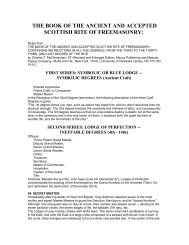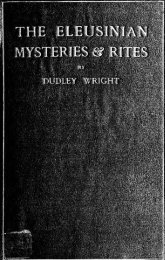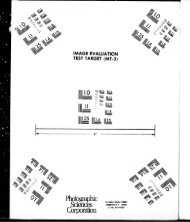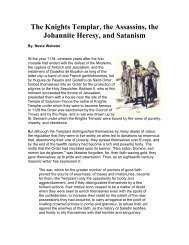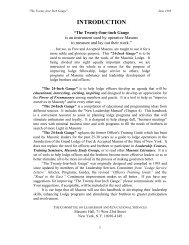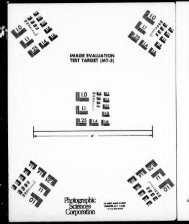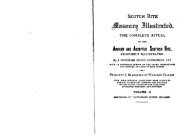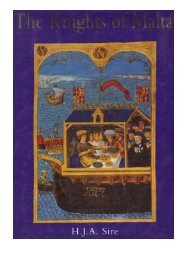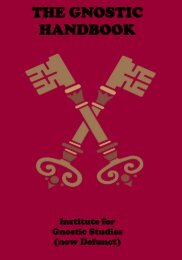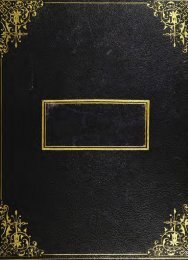The History of Initiation - The Masonic Trowel
The History of Initiation - The Masonic Trowel
The History of Initiation - The Masonic Trowel
You also want an ePaper? Increase the reach of your titles
YUMPU automatically turns print PDFs into web optimized ePapers that Google loves.
INTO THE GOTHIC MYSTERIES. 167<br />
people, were three ; the most magnificent <strong>of</strong> which commenced<br />
at the winter solstice, and was celebrated in<br />
honour <strong>of</strong> Thor, the prince <strong>of</strong> the power <strong>of</strong> the air. 8<br />
It<br />
was commemorative <strong>of</strong> the creation; for, being the<br />
longest night in the year, 9<br />
they assigned to it the formation<br />
<strong>of</strong> the world from primeval darkness, and called it<br />
MOTHER-NIGHT. This festival was denominated Yule,<br />
Juul, or Yeol, 11 12<br />
and was a season <strong>of</strong> universal festivity.<br />
At the nocturnal meetings <strong>of</strong> this sacred celebration, the<br />
for it was<br />
initiations were performed on a superb scale ;<br />
believed that the succeeding season would be fruitful or<br />
unpropitious, in proportion with the sumptuous 13 or<br />
8<br />
VerstegSn says, that " in the ayre hee gouerned the wyndes and<br />
the clowdes ;<br />
and, being displeased, did cause lightning, thunder, and<br />
tempests, with excessive rain, and all il weather. But, being wel<br />
pleased by the adoration, sacrifice, and seruice <strong>of</strong> his supplyants, hee<br />
then bestowed upon them most fayre and seasonable weather and<br />
;<br />
caused corne abundantly to growe as also all sortes <strong>of</strong> ; fruites, &c. 3<br />
and kept away from them the plague, and all other evill and infectious<br />
diseases." (Rest. Dec. In tell., p. 75.)<br />
9 <strong>The</strong> feast was, in fact, sacred to Darkness, that great and awful<br />
principle which was a stumbling-block to the whole heathen world.<br />
Mai. North. Ant., vol. i.. p. 358.<br />
1<br />
Vid. Jamieson. Scott. Diet., v. Yule.<br />
12 When Christianity was first promulgated in the northern nations,<br />
the missionaries found the inhabitants unwilling to relinquish this<br />
annual rejoicing; the festival was, therefore, applied to the nativity<br />
<strong>of</strong> Christ ; and hence the Yule Feast was denominated Christmas. On<br />
the eve <strong>of</strong> the first day <strong>of</strong> the festival or Mother-Night, fires <strong>of</strong> wood<br />
blazed throughout the whole extent <strong>of</strong> northern Europe hence ; the<br />
origin <strong>of</strong> our Yule-clog. <strong>The</strong> peace-<strong>of</strong>ferings dedicated to Thor at<br />
this season were cakes <strong>of</strong> flour sweetened with honey; hence the<br />
Yule-cake. Subjects at this festival presented their annual gifts or<br />
benevolences to their sovereign (Johnston, Antiq. Celto-Scand., p.<br />
230) hence ; Christmas-boxes, New-year-gifts, fyc. <strong>The</strong> candles <strong>of</strong> the<br />
Sun were said to illuminate the northern dwellings on the night before<br />
Yule ; and hence arose the custom <strong>of</strong> burning large candles at this<br />
solemnity ; for it boded ill luck to the family for the succeeding year<br />
if a second candle were lighted; whence our Yule-candles. (Vid.<br />
Jamieson, Scot. Diet., v. Yule, vi.)<br />
I am informed by a Danish<br />
Brother, that cakes are still made in Denmark, <strong>of</strong> a particular form, at<br />
this season, composed <strong>of</strong> the finest<br />
flour, eggs, currants, and other<br />
ingredients and ; are called Juule-Kdger.<br />
is "<strong>The</strong> ancient inhabitants <strong>of</strong> the North were never at a loss for<br />
the means <strong>of</strong><br />
celebrating their Yule. Johnson (Antiq. Celto-Normann.)<br />
has a note referring to this subject, which exhibits their character in<br />
its true light. <strong>The</strong> Scandinavian expeditions, he says, were anciently<br />
conducted in the following manner: A chieftain sailed with a few<br />
ships for Britain, and collected all the scattered adventurers he could<br />
find in his way. <strong>The</strong>y landed on the coast, and formed a temporary<br />
I<br />
"-<br />
,1



